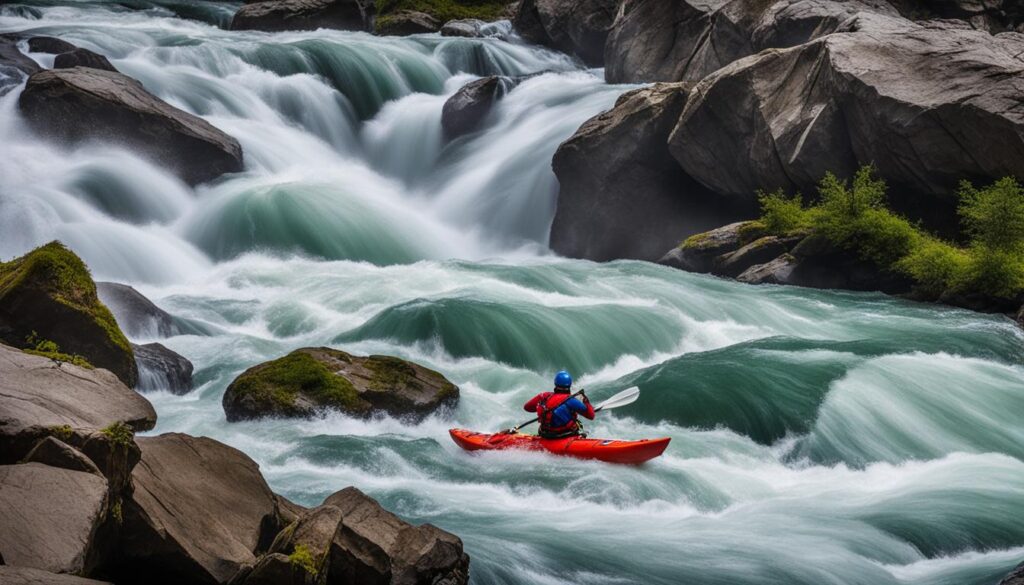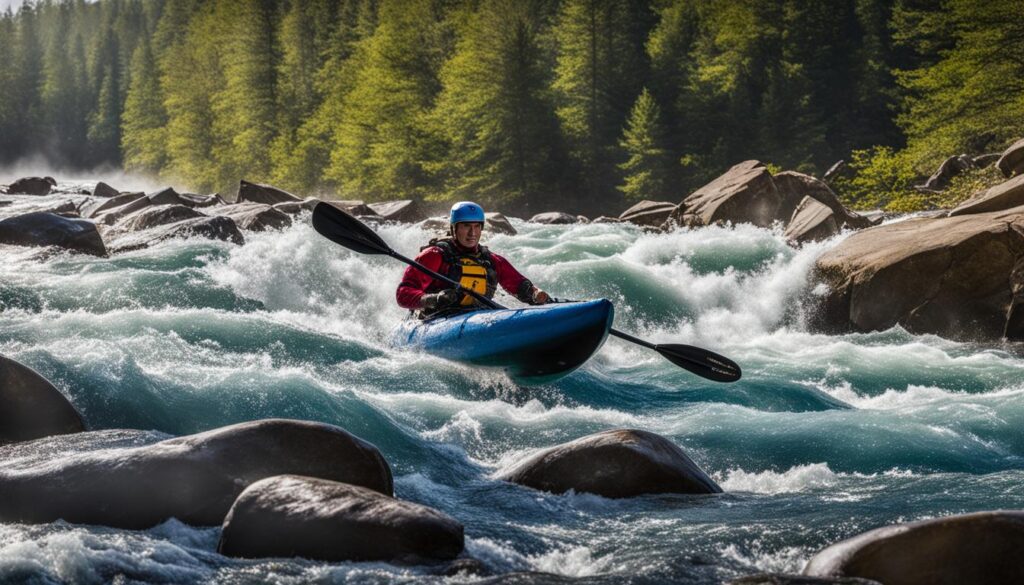As a kayaker, understanding river rapid grades is essential for planning your trips and assessing the challenges you may face on the water. River rapid grades are a classification system that helps determine the difficulty level of rapids, ranging from class I to class VI. Each class represents a different level of skill, experience, and technical ability required to navigate the rapids safely.
Factors such as water flow, obstacles, drop heights, and rock formations contribute to the classification of a rapid. It’s important to accurately assess your own skill level and choose rapids that align with your abilities to ensure a safe and enjoyable experience on the water.
Key Takeaways:
- Understanding river rapid grades is crucial for kayakers to assess the difficulty level of rapids.
- The classification system ranges from class I to class VI, with class I being the easiest and class VI being the most difficult.
- Factors such as water flow, obstacles, drop heights, and rock formations contribute to the classification of a rapid.
- Kayakers should accurately assess their own skill level and choose rapids that align with their abilities for a safe and enjoyable experience.
- By understanding and interpreting whitewater classifications, kayakers can assess potential challenges and plan their trips accordingly.
Understanding Kayaking Difficulty Levels
When it comes to kayaking, understanding the different difficulty levels of rapids is crucial to ensure a safe and enjoyable experience on the water. Rapids are classified into various levels, with class III, IV, and V being commonly encountered by kayakers. Let’s take a closer look at what each of these classes entails.
Kayaking Difficulty Levels
Class III rapids: These rapids are considered intermediate-level and offer moderate waves, obstacles, and technical challenges. They require a certain level of skill and experience to navigate successfully. Class III rapids are an excellent choice for kayakers who have some experience and want to challenge themselves further.
Class IV rapids: Advancing to class IV represents a significant step up in difficulty. These rapids feature larger waves, faster currents, and more complex maneuvers. Kayakers need to have advanced technical skills, decision-making abilities, and the ability to adapt to changing water conditions to navigate class IV rapids safely.
Class V rapids: Expert-level kayakers tackle class V rapids, which are known for their large, unpredictable waves, difficult maneuvers, and potential hazards. Navigating these rapids requires precise navigation skills and a deep understanding of whitewater kayaking. Class V rapids present a significant challenge for even the most experienced kayakers.
As a beginner, it’s important to start with lower-class rapids, such as class I and II, to develop your skills and gain experience. Gradually progress to higher classes as you become more confident and proficient in your kayaking abilities.

Comparing Class III, IV, and V Rapids
| Rapid Class | Rapid Characteristics | Required Skills |
|---|---|---|
| Class III | Moderate waves, obstacles, and technical challenges | Intermediate-level skills and experience |
| Class IV | Larger waves, faster currents, and more complex maneuvers | Advanced technical skills and decision-making abilities |
| Class V | Large, unpredictable waves, difficult maneuvers, and potential hazards | Expert-level navigation skills and deep knowledge of whitewater kayaking |
Understanding the different difficulty levels of rapids is essential for kayakers. It allows you to assess the challenges you’ll face on the water and choose suitable rapids that align with your abilities. Remember to always prioritize safety and gradually progress as you enhance your skills and gain more experience in kayaking.
Assessing Rapid Challenges
Kayaking skill level assessment is an important step in planning your trips and ensuring a safe and enjoyable experience on the water. By accurately assessing your own skill level, you can choose rapids that align with your abilities and comfort level. When assessing your skill level, consider factors such as your experience, technical ability, comfort level in different water conditions, and familiarity with specific maneuvers.
Planning trips based on rapid grades involves researching the classification of the rapids along your route. This allows you to determine if they align with the skill levels of all participants. It’s essential to understand and interpret whitewater classifications to assess the potential challenges you may face. Factors such as steep drops, powerful currents, and technical maneuvers can significantly impact the difficulty level of a rapid.
External factors such as water flow and weather conditions should also be taken into consideration when assessing rapid challenges. These factors can influence the overall difficulty and safety of navigating certain rapids. Additionally, keep an eye out for any specific hazards or obstacles that may be present in the rapids, as these can further impact the level of challenge.
| Rapid Classification | Difficulty Level | Key Characteristics |
|---|---|---|
| Class I | Easy | Gentle currents, minimal obstacles |
| Class II | Intermediate | Moderate waves, some obstacles |
| Class III | Advanced | Larger waves, faster currents, technical challenges |
| Class IV | Expert | Unpredictable waves, complex maneuvers, potential hazards |
| Class V | Extreme | Large, powerful waves, precise navigation required |
| Class VI | Unrunnable | Exceedingly dangerous, only attempted by highly skilled professionals |
By understanding rapid classifications and assessing your own skill level, you can navigate rapids that provide an appropriate level of challenge for your abilities. Remember to always prioritize your safety and enjoyment on the water by choosing rapids that align with your skill level and comfort.

Beginner vs. Advanced Rapid Grades
When it comes to kayaking, understanding the difficulty levels of river rapids is essential. The river rapid grading system provides a standardized classification that allows kayakers to assess the challenges they may face on the water. It’s important to know where you stand in terms of skill progression and technical abilities to choose the right rapids for your level of expertise.
Beginner kayakers should start with class I and II rapids, which are considered easy and provide a gentle introduction to whitewater kayaking. These rapids typically have minimal obstacles and moderate waves, allowing beginners to comfortably navigate through them. As you gain experience and develop your technical abilities, you can progress to higher class rapids.
Advanced kayakers who have mastered the skills required for class III rapids can challenge themselves by tackling class IV and V rapids. These advanced rapids require a higher level of skill, quick decision-making, and the ability to adapt to changing water conditions. They are characterized by larger waves, faster currents, and more complex maneuvers.
Developing your technical abilities is crucial for successfully navigating advanced rapids. Practice, training, and experience play an important role in improving your skills and ensuring your safety on the water. By continually progressing and pushing your boundaries, you can expand your kayaking horizons and tackle more challenging rapids.
| Beginner Rapid Grades | Advanced Rapid Grades |
|---|---|
| Class I and II | Class III and above |
| Easy and gentle introduction to whitewater kayaking | Require a higher level of skill and experience |
| Minimal obstacles, moderate waves | Larger waves, faster currents, and more complex maneuvers |
Remember, always assess your own skill level and comfort level in different water conditions when choosing rapids. It’s important to challenge yourself but also ensure your safety and enjoyment on the water. With the right progressions, you can become a skilled kayaker capable of navigating even the most challenging rapids.
Conclusion
Understanding river rapid grades is crucial for kayakers as it allows you to interpret the characteristics and challenges of different rapids. The river rapid grading system provides a standardized classification that aids in assessing the difficulty level of rapids and choosing suitable challenges.
Assessing rapid challenges involves considering factors such as your skill level, experience, and comfort level in different water conditions. By accurately assessing your abilities and choosing rapids that align with your skill level, you can ensure a safe and enjoyable experience on the water.
Remember, the river rapid grading system is just a tool to guide you. It’s important to continually progress and improve your skills through practice, training, and experience. By doing so, you can confidently navigate more challenging rapids and embark on thrilling adventures on the water.
FAQ
What are river rapid grades?
River rapid grades are a classification system used to assess the difficulty level of rapids for kayakers.
Why is understanding river rapid grades important for kayakers?
Understanding river rapid grades is crucial for kayakers as it helps them plan their trips and assess the challenges they may face on the water.
How are river rapid grades classified?
The classification system ranges from class I to class VI, with class I being the easiest and class VI being the most difficult.
What factors contribute to the classification of a rapid?
Factors such as water flow, obstacles, drop heights, and rock formations contribute to the classification of a rapid.
How can kayakers assess their own skill level?
Kayakers can assess their own skill level by considering factors such as their experience, technical ability, comfort level in different water conditions, and familiarity with specific maneuvers.
What are class III rapids?
Class III rapids are considered intermediate-level rapids with moderate waves, obstacles, and technical challenges.
What are class IV rapids?
Class IV rapids are advanced and require a higher level of skill and experience, with larger waves, faster currents, and more complex maneuvers.
What are class V rapids?
Class V rapids are expert-level and are characterized by large, unpredictable waves, difficult maneuvers, and potential hazards that require precise navigation.
How should beginners start their kayaking journey?
Beginners should start with class I and II rapids to develop their skills and gradually progress to higher classes as they gain experience.
How can kayakers choose rapids that match their skill level?
Kayakers should assess their own skill level and choose rapids that align with their abilities and comfort level to ensure safety and enjoyment on the water.
How can kayakers plan trips based on rapid grades?
Planning trips based on rapid grades involves researching the classification of the rapids along the route and determining if they align with the skill levels of all participants.
What does understanding and interpreting whitewater classifications allow kayakers to do?
Understanding and interpreting whitewater classifications allows kayakers to assess the potential challenges they may face, such as steep drops, powerful currents, and technical maneuvers.
How can advanced kayakers challenge themselves?
Advanced kayakers who have mastered the skills required for class III rapids can challenge themselves by tackling class IV and V rapids.
How can kayakers improve their skills to safely navigate more challenging rapids?
Kayakers can improve their skills through practice, training, and experience to safely navigate more challenging rapids.
Why is understanding river rapid grades essential for kayakers?
Understanding river rapid grades is essential for kayakers as it allows them to assess the difficulty level of rapids and choose suitable challenges.
How can kayakers confidently navigate rapids?
With a solid understanding of river rapid grades, kayakers can confidently navigate rapids and embark on thrilling adventures on the water.





